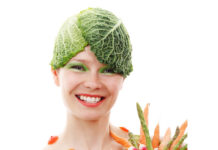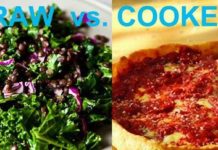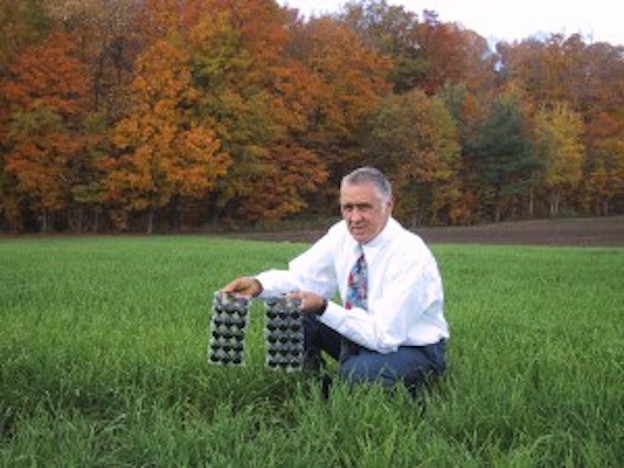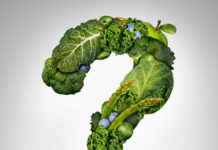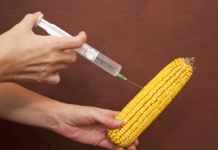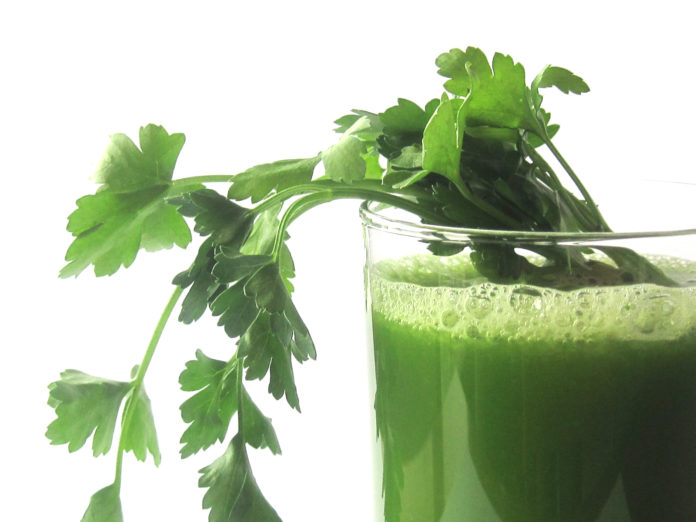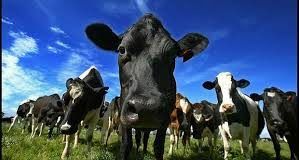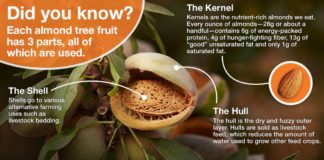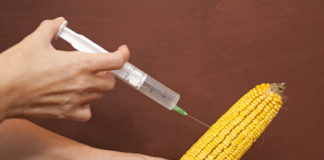Juicing is a one of the easiest yet most powerful things you can use to make your raw food lifestyle more successful – and improve your overall health and wellness. Usually I juice every day and drink between one or two quarts of mostly-green juice every day. Some people prefer to have one regular juice day every week, also called a juice ‘feast’ or juice fast day.
By removing all the hard-to-digest fiber from your nutrient-rich veggies, juicing improves your absorption of all the important nutrients. This is particularly important for people beginning a raw food lifestyle because most of us have poor digestion and incomplete absorption after decades of eating cooked and processed foods. Juicing, using only a slow-speed masticating juicing to protect t he nutrients, breaks down the cell walls of your veggies releasing the nutrition so you can absorb it like a sponge.
How Much to Drink
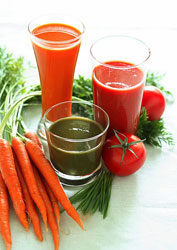 I usually recommend at least 16 ounces of juice daily. Most days I fill up a 16 oz. insulated sports canister and drink it throughout the day. When I am doing a juice ‘feast’ I double that, drinking it throughout the day, but mostly around meal times or whenever I am feeling hungry.
I usually recommend at least 16 ounces of juice daily. Most days I fill up a 16 oz. insulated sports canister and drink it throughout the day. When I am doing a juice ‘feast’ I double that, drinking it throughout the day, but mostly around meal times or whenever I am feeling hungry.
Making this much juice every day might seem tedious, but I have a secret. First, I don’t actually make juice every single day. I actually juice every two or three days and make enough for the next two or three days, which I then store in a tightly sealed, insulated container in the fridge. If you do this a lot you may want to get one of those food saver appliances that sucks the air out of a ball-jar style container, but I have found that my juice lasts up to 3 days just fine without that – though as always, the sooner you drink it the better!
In order to do this you MUST you only a high quality masticating juicer that produces little oxidation hence has a high juice quality and juice stability. These include single-auger juicers like those made by Samson, Hurom, Omega and Kuvings and twin-gear models like the Green Power, Green Star and Super Angel.
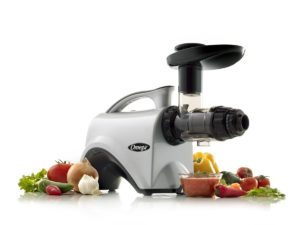 If you are new to juicing I recommend a single-auger juicer. Avoid low-cost, high-speed centrifugal juicers entirely (like the Juiceman or Jack LaLanne models) because they break easily, produce low quality juice, and are very loud. Most importantly, they have the lowest juice quality because they fling tiny droplets of juice through the air to separate it from the pulp, and this thoroughly oxidizes all the juice before it even reaches the glass! Oxidation is the enemy of nutrition, enzymes and health in general. So plan on spending between $200-300 for a good single-auger juicer.
If you are new to juicing I recommend a single-auger juicer. Avoid low-cost, high-speed centrifugal juicers entirely (like the Juiceman or Jack LaLanne models) because they break easily, produce low quality juice, and are very loud. Most importantly, they have the lowest juice quality because they fling tiny droplets of juice through the air to separate it from the pulp, and this thoroughly oxidizes all the juice before it even reaches the glass! Oxidation is the enemy of nutrition, enzymes and health in general. So plan on spending between $200-300 for a good single-auger juicer.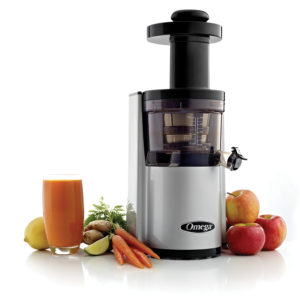
The next step up is a vertical slow speed juicer, starting around $400. These are great for smaller counters since they take less space. While they do a good job of juicing, they are not multipurpose kitchen tools like some other juicers, i.e., they just make juice. That’s it!
As your juicing expertise grows you may want to trade up to a twin-gear juicer, which start around $500. These are the best juicer when you talk about juicing efficiency (more juice from the same veggies), juice quality (more nutritional density from the same veggies), juice stability (longer lasting in the fridge) and ease of use or cleaning. Beyond that there is something ca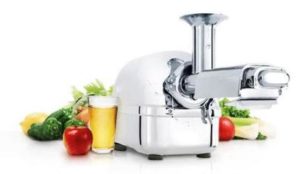 lled the juice press, but these are thousands of dollars, are very messy and tedious to use or clean for very little additional benefit compared to the best twin-gear model from Super Angel. In fact, I have sold many Super Angel juicers to people who own hydraulic juicers that just cannot stand them any more!
lled the juice press, but these are thousands of dollars, are very messy and tedious to use or clean for very little additional benefit compared to the best twin-gear model from Super Angel. In fact, I have sold many Super Angel juicers to people who own hydraulic juicers that just cannot stand them any more!
Once you get used to your new juicer and start enjoying all the benefits, you’ll be surprised to discover that it’s much easier than you thought it would be. In fact, it can be a lot of fun! After many years, I’ve got my juicing down to a routine that usually takes less than 15 minutes including clean up. Since I only juice every two or three days, I only have to clean up every two or three days, too. I generally just rinse all t he juicer components under hot water and toss them in the dish rack. I clean and brush the juicing gears and juicing screen more thoroughly. One or twice a week I scrub everything more thoroughly using soapy water.
Though most of the nutrients are removed from the pulp by your juicer, it is still a valuable resource. I mix my pulp with my dog’s food – and he loves it! It makes a great topping for almost anything, especially salads. You can also compost it.
Introduction to Juicing for Healing Disease
 When I first went to the Optimum Health Institute in San Diego (OHI) as a guest for three weeks, mostly to accompany my elderly mother, I was the poster boy in my neighborhood for Chronic Fatigue Syndrome (CFIDS). After years of trying all kinds of alternative therapies, from Chinese medicine to homeopathy, Tai Chi, acupuncture and much more, I had some limited success and actually thought at the time I was cured since I no longer had to sleep all day long – and could actually stay awake most of a day. But in reality I had forgotten what normal felt like.
When I first went to the Optimum Health Institute in San Diego (OHI) as a guest for three weeks, mostly to accompany my elderly mother, I was the poster boy in my neighborhood for Chronic Fatigue Syndrome (CFIDS). After years of trying all kinds of alternative therapies, from Chinese medicine to homeopathy, Tai Chi, acupuncture and much more, I had some limited success and actually thought at the time I was cured since I no longer had to sleep all day long – and could actually stay awake most of a day. But in reality I had forgotten what normal felt like.
The program at OHI begins with a 3-day juice “feast” or fast. After three days on simple, basic juices I suddenly felt more energy than I had in years and years. I realized then that not feeling noticeably “sick” was not the same thing as being wonderfully alive and bursting with more energy than I knew what to do with.
Before that first juice feast I was walking around like a zombie that didn’t know it was dead. If you reached out to shake my hand and introduce yourself, I would stick a limp arm out and offer a weak hello in reply. But after the juice fast I was genuinely excited to meet people, and thrilled to make new friends. I walked around with a perpetual smile on my face the whole time I was there and made lots of new friends.
In fact, I was so impressed by the miraculous transformation in my life that a few months later I returned to OHI as a volunteer, agreeing to work there for 3 months in exchange for room and board. I ended up staying there for six years, losing over 75 lbs. and changing my life forever.
The OHI program is a comprehensive, life-altering program of juicing vegetables and wheatgrass combined with detoxification and an intense education in nutrition, physiology and other ltd topics – but juicing is the core nutritionally!
My experience after the first few days is not the exception! In fact, my mother, who was in her 70’s and extremely overweight at the time, had a similar experience. On the first day we had to change her room to a more expensive room closer to the main buildings because she couldn’t even walk up a flight of stairs. After the first week she was a different woman, walking all over the place, up and down stairs, with a glow I hadn’t seen in decades.
Realistically, though you may experience intense highs at first, you can also experience uncomfortable lows associated with detoxifying your body. So it is important when you undertake a any juicing program or any juice feast longer than a day or so to support your body’s excretory system in removing released toxins with colon-cleansing techniques such as colonic irrigation or even just a daily enema. The colon is one of the most important organs for eliminating waste during detox and if no food is moving through it you need to give it some help. I also recommend not to attempt juice feasting for more than three days without professional guidance like we had at OHI. That much intense fasting is usually not required to achieve amazing results and get quite uncomfortable and even dangerous for some people.
Real, lasting transformational results, of course, only come after months or even years of making raw food part of your lifestyle. At first you may only be half raw, but you can ad to that bit by bit, cleansing and educating yourself along the way until months later you are 75% raw, then 80%, and so on. The more raw food you eat the faster your body can eliminate backed up toxins.
In my experience, if you eat at least 75% or more of your diet as raw, live food, in about three months you’ll start to see dramatic improvements in your health. That’s because it takes that long for your body to replace most of it’s red blood cells. So don’t expect juicing to be a magic bullet or overnight miracle in every case.
You’ll probably notice some immediate benefits like Mom and me, but you will also go through ups and downs in your personal process of growth and transformation. Even living at a raw food health center, it took me 6 years to become 100% raw…and that only lasted a few years before moving to another state caused new challenges and issues in my life. One thing is certain, I think, and that is the ups as well as the downs are much easier to enjoy as a raw foodist, just like riding a roller coaster and laughing all the way.
Best Vegetables for Juicing
 The most powerful ingredients for your juice are the dark green leafy vegetables. These are the most alkaline-forming vegetables, but they don’t taste as good as the veggies we are typically used to in the market. So to compensate for that I add just one or two carrots, a lemon or an apple. I recommend not making the juice any sweeter than that because it will exacerbate any problems your body has with sugar metabolism.
The most powerful ingredients for your juice are the dark green leafy vegetables. These are the most alkaline-forming vegetables, but they don’t taste as good as the veggies we are typically used to in the market. So to compensate for that I add just one or two carrots, a lemon or an apple. I recommend not making the juice any sweeter than that because it will exacerbate any problems your body has with sugar metabolism.
Even if you aren’t diagnosed with a sugar problem, you probably have borderline, undiagnosed sugar issues results from sugar being added to everything in your cooked, processed diet for your whole life. So limit your use of sweet veggies like carrots and beets, and try to eliminate most fruit at least until your body rehabilitates it’s ability to properly metabolize sugars. Avoid fruit and sweet veggies entirely if you have candida, hypoglycemia, insulin resistance, diabetes, or cancer.
Juicing Tips
- Start juicing the vegetables that you already enjoy eating whole so you won’t be overwhelmed with strange flavors right away – you should enjoy your juice!
- Never juice orange or grapefruits peels since they contain toxic oils.
- Rotate vegetables and try new recipes regularly to get a variety for best nutrition and to avoid developing sensitivities or allergies from too much of the same thing constantly.
NOTE: Unless you are doing a controlled juice fast or detoxification program, please don’t use juice as a meal replacement. Juice has very little protein and almost no fat so it cannot replace a nutritious meal. It is really just a powerful nutritional supplement or boost to your diet, ideally used in addition to regular meals.
My favorite veggies for juicing …
(organic and washed thoroughly, of course)
- Dark green leafy veggies like collard greens, Swiss chard and kale
- Celery
- Parsley (high in vitamin C, bioflavanoids, iron, minerals and chlorophyll)
- Cucumbers (with skin)
- Leftover veggies in the fridge (broccoli, cauliflower, sprouts, whatever)
- Carrots (use sparingly due to high sugar content)
- Ginger root, for its anti-inflammatory properties
- Lemons (high in vitamin C & bioflavanoids.
My Favorite Juicing Recipes
Mock V-8 Juice
- 1/4 cup spring water
- 2 tomatoes
- 2 cloves garlic
- 1 handful spinach
- 1/4 sweet onion
- 1-2 celery stalks
- 2 tsp. lemon juice
- 1-2 shots hot sauce to taste
Cucumber Celery Cooler
- 4 medium carrots, greens removed
- 1/4 medium cucumber, peeled
- 1 stalk celery
- 1 apple, sliced
- 1/2 lemon, peeled (optional)
Mock Tuna Salad Using Juicer Pulp
- carrot or vegetable pulp
- raw mayonnaise (see link below)
- whatever else you’d like (celery, onions, etc.)
Add raw mayonnaise to your juicer pulp. Add other veggies to taste (scallions, celery, etc.).
Add spices to taste. Add to salad dressings, use on greens, etc.
My dog, Buddy, also LOVES the pulp from my juicer, which I regularly share with him!
Click here for more juicing recipes
Also Read:


